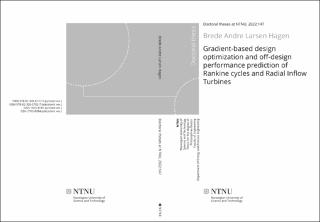| dc.contributor.advisor | Nekså, Petter | |
| dc.contributor.advisor | Andresen, Trond | |
| dc.contributor.advisor | Nord, Lars O. | |
| dc.contributor.author | Hagen, Brede Andre Larsen | |
| dc.date.accessioned | 2022-05-05T07:48:24Z | |
| dc.date.available | 2022-05-05T07:48:24Z | |
| dc.date.issued | 2022 | |
| dc.identifier.isbn | 978-82-326-5782-7 | |
| dc.identifier.issn | 2703-8084 | |
| dc.identifier.uri | https://hdl.handle.net/11250/2994279 | |
| dc.description.abstract | A major fraction of today's electricity is generated by Rankine cycle power systems utilizing the thermal energy of fossil sources such as coal and natural gas, or nuclear energy. However, the carbon content in the fossil energy sources and concern of nuclear radiation are driving forces for adapting the Rankine cycle technology towards other applications. Indeed, solar radiation, geothermal heat, biomass, and industrial surplus heat are regarded as safe and environmentally friendly heat sources for Rankine cycle power systems. A Rankine cycle power system generates electricity using a working fluid circulating between the heat source and a heat sink. In the majority of cases, this working fluid is steam and the power is generated by a steam turbine that is connected to a generator. However, it is challenging to design effective low capacity (below a few MWe) steam turbines, which is often the case for environmentally friendly heat sources. However, this turbine design challenge can be overcome by instead using an organic substance or CO2 as the working fluid.
In contrast to steam Rankine cycles whose designs are more or less standardized, the consideration of alternative working fluids leads to many candidates for cycle configuration and component design. This thesis proposed methods to design and analyze Rankine cycles and their major components. The underlying mathematical models are formulated in a general way and combine several engineering disciplines such as applied thermodynamic, heat transfer, and fluid flow. This means that the methods are valid for a large range of operating conditions and working fluid candidates. The mathematical models were also formulated to minimize the computational cost. Indeed, the methods apply an efficient gradient-based optimization algorithm for solving a system of equations and optimizing the degrees of freedom simultaneously. The methods also support several novel control approaches that improve the Rankine cycle performance at off-design operating conditions. This means that the methods are especially useful for applications where the characteristics of the heat source or the heat sink vary with time.
The capabilities of the proposed methods were demonstrated for the case of power production from a highly time-dependent heat source at a representative Norwegian ferroalloy plant. This case study considered a heat recovery system that captured, smoothed, and delivered the heat that is released from the process of batch-wise metal casting to a Rankine cycle. Three designs for this Rankine cycle were generated. In addition, the annual electricity production that can be obtained from each of these Rankine cycles was estimated considering four different control approaches. The “standard” sliding pressure control approach yielded an annual electricity production of up to 11.6 GWh. In addition, the annual electricity production can be increased by more than 10% by considering novel control approaches or adjusting the design operating point. | en_US |
| dc.language.iso | eng | en_US |
| dc.publisher | NTNU | en_US |
| dc.relation.ispartofseries | Doctoral theses at NTNU;2022:147 | |
| dc.relation.haspart | Paper 1: Paper I A novel methodology for Rankine cycle analysis with generic heat exchanger models Brede A. L. Hagen, Monika Nikolaisen, Trond Andresen, Applied Thermal Engineering, vol. 165, no. 114566, 2020. DOI: https://doi.org/10.1016/j.applthermaleng.2019.114566 This is an open access article under the CC BY license | en_US |
| dc.relation.haspart | Paper 2: Gradient Based Design Optimization of a Radial Inflow Turbine Brede A. L. Hagen, Matteo Cavo, Trond Andresen, Petter Nekså, in IIR Rankine 2020 Conference, 2020. http://dx.doi.org/10.18462/iir.rankine.2020.1143 | en_US |
| dc.relation.haspart | Paper 3: Hagen, Brede; Agromayor, Roberto; Nekså, Petter. Equation-oriented methods for design optimization and performance analysis of radial inflow turbines. Energy 2021 ;Volum 237. https://doi.org/10.1016/j.energy.2021.121596 This is an open access article under the CC BY license | en_US |
| dc.relation.haspart | Paper 4: Hagen, Brede Andre Larsen; Andresen, Trond; Nekså, Petter. Equation-oriented methods for optimizing Rankine cycles using radial inflow turbine. Energy 2022 https://doi.org/10.1016/j.energy.2022.123909 This is an open access article under the CC BY license | en_US |
| dc.relation.haspart | Paper 5: Andresen, Trond; Lingaas, Simon Johan Nilsen; Hagen, Brede; Nekså, Petter. Dynamic Analysis of Energy Recovery Utilizing Thermal Storage from Batch-Wise Metal Casting. I: IIR Rankine Conference 2020. http://dx.doi.org/10.18462/iir.rankine.2020.1144 | en_US |
| dc.title | Gradient-based design optimization and off-design performance prediction of Rankine cycles and Radial Inflow Turbines | en_US |
| dc.type | Doctoral thesis | en_US |
| dc.subject.nsi | VDP::Technology: 500::Environmental engineering: 610 | en_US |
